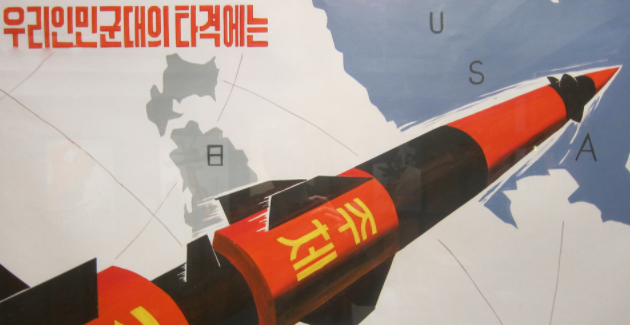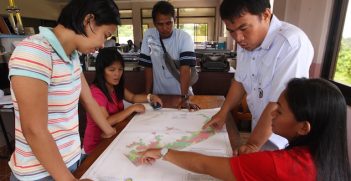The Secret to North Korea’s Nuclear Ambitions

Doves and hawks see the North Korean nuclear program as a response to US policies or as a product of its internal politics. Neither is fully correct. These positions underestimate the structural factor, the massive US military presence on the Korean Peninsula,.
The United States has long called for the “complete, verifiable, irreversible denuclearization” of North Korea, a policy known as ‘CVID’. But is this a realistic policy option? More broadly, what are the drivers of North Korea’s continued interest in nuclear weapons?
The majority of analysis answers this broader question from one of two basic positions. On one side are the doves, arguing that North Korea clings to its nuclear weapons because it is threatened militarily, isolated politically and ailing economically. Therefore, they continue, if the international community can ameliorate North Korea’s security concerns, engage it politically and aid it in its economic development, the rationale for the nuclear program would disappear and the North would likely abandon it.
On the other side are the hawks, claiming that the North’s nuclear program is driven by psychological proclivities, domestic political incentives, extortionary motives and revisionist intentions. The hawks therefore argue that reducing military pressure on the North will likely only whet its appetite, economic aid will only feed its nuclear program, and political engagement is ultimately unlikely to be decisive in dealing with the North’s nuclear program.
However, as I argue in a recent article in the Australian Journal of International Affairs, both sides are partly right and partly wrong. The doves are correct that that the North Korean nuclear program is largely intended to ensure their external security. Yet what they get wrong is the claim that negative security assurances from the United States are the answer to the North’s security concerns.
The hawks’ case
The hawks, for their part, are correct that North Korea is unlikely to abandon its nuclear weapons program. However, by focusing on the North’s internal drivers of proliferation, they miss the more important external motivations of the nuclear program. In contrast to both the dove and the hawk positions, it is the well-known but often overlooked fact of the power of the United States and its position of forward deployment on the Korean Peninsula that primarily motivates the North’s nuclear program.
The reason this is the case is that the progress of North Korea’s nuclear program has been a constant, yet many of the factors pointed to by the doves and the hawks have varied a great deal. True, the North did freeze its plutonium program under the Agreed Framework between 1994 and 2002. Yet this is precisely when it is believed to have started its highly enriched uranium program, and the North’s ballistic missile program has similarly continued unabated.
The doves’ case
If, as the doves argue, North Korea’s interest in nuclear weapons is due to the threatening military policies emanating from the US, we might expect expressions of non-hostile intent to lead it to slow or abandon its nuclear activities. However, such expressions have been offered by US presidents dozens of times since the late 1980s without much effect. Furthermore, the major annual US-South Korea Team Spirit military exercises—often deemed “highly provocative” by North Korea—were halted in the interest of better relations in 1992, then again in 1994 and thereafter. Yet the North obtained uranium enrichment technology and advanced its missile technology during these years.
Alternatively, if North Korea develops its nuclear program due to its political isolation from members of the international community, we might expect sustained political engagement to dampen its nuclear ambitions. However, while there has been a great deal of variation in the amount of inter-Korean dialogue, there has been far less in the North’s nuclear policy. Similarly, if economic underdevelopment is the primary driver of the North’s nuclear program, it is odd that we’ve seen so much variation in inter-Korean trade and international food aid to the North, but far less in its nuclear policy. Something else appears to be at work.
The hawk arguments have similarly problems. If, as the hawks argue, the North’s proliferation is driven by its leaders’ psychological proclivities or revisionist intentions, it is notable that there has been so little meaningful variation between the nuclear policies of grandfather Kim Il-sung, father Kim Jong-il, and son Kim Jong-un. The recent increases in proliferation activity under Kim Jong-un could just as easily reflect an increase in technological sophistication as a fundamental change in policy. Other hawks have argued that the North’s nuclear ambitions are driven by its desire to extort international aid. However, the pattern of aid and proliferation is far more consistent with North Korean need, particularly during the famine of the 1990s, than with its ability to use its nuclear sabre-rattling as an extortion tool.
A final argument made by hawks is that the North Korean leadership may use its nuclear program to appease domestic political supporters, including the military. But the role of the military in North Korean politics has waxed and waned a great deal over the years, and not in ways that are clearly related to the nuclear program. For instance, it is puzzling from this perspective that it is during the plutonium freeze of the Agreed Framework years (1994-2002) that the military rose to its central position in North Korean politics.
US power
Thus, while many of the factors pointed to by the dove and hawk arguments vary, North Korean proliferation does not. This suggests there is an unmoving, more fundamental driver at work. This is US power and its position of forward-deployment on the Korean Peninsula. If it is the raw fact of US power and its position on the Korean Peninsula that is driving the North Korean nuclear program, rather than US or South Korean foreign policy or the revisionist intentions of the North Korean leadership, then we should expect the North to advance the program as long as the US is present, without variation. This is exactly what we see.
Returning to the policy questions: Is CVID a realistic policy option? Is North Korea likely to abandon its nuclear program? So long as the US maintains a significant military presence on the Korean Peninsula, North Korea will be highly unlikely to abandon its nuclear program, regardless of the various combinations of threats and incentives that might be put forward. In calling for ‘complete, verifiable, and irreversible denuclearisation’, while retaining the US-South Korea alliance and stationing tens of thousands of troops in the South, the US seems to want to have its cake and to eat it too. It is the power and the very presence of the United States that makes its own desired policy unworkable. And if this is the case, then CVID is a non-starter.
Nicholas Anderson is a doctoral candidate in the Department of Political Science at Yale University and an exchange scholar in the Department of Political Science at UC-Berkeley.
This article is adapted from a longer article published by the Australian Journal of International Affairs on 2 May 2017.





